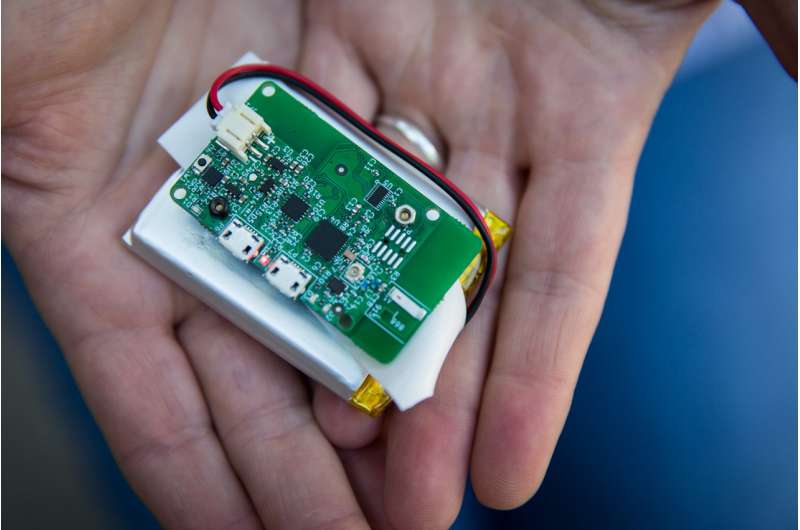Hacked open artificial pancreas system (OpenAPS). Credit: University of Utah Health
The diabetes online community is leading grassroots efforts focused on accelerating the development, access and adoption of diabetes-related tools to manage the disease. Researchers at University of Utah Health examined the community's online Twitter conversation to understand their thoughts concerning open source artificial pancreas (OpenAPS) technology. The results of this study are available online in the September 10 issue of the Journal of Diabetes Science and Technology.
"There is a large community that is actively exploring how they can manage their diabetes using off-label solutions," says Michelle Litchman, Ph.D., FNP-BC, FAANP, an assistant professor in the College of Nursing at U of U Health and first author on the paper. "Health care providers, industry and the FDA need to understand the wants and needs of people with diabetes in order to better serve them. OpenAPS was created out of a need for better solutions."
For the diabetes community, OpenAPS has been touted as an ideal technology for managing their illness. The off-label technology combines an off-the-shelf continuous glucose monitor (CGM) and insulin pump that interact to minimize glucose variability.
Before the Food and Drug Administration (FDA) approved the first technology to bridge these two devices in 2017, the community took matters into their own hands. They hacked into current CGMs and older insulin pumps and developed open source code to get the two devices to speak to one another, creating an OpenAPS. By crowdsourcing their code hacks, the community has improved this approach for blood sugar management.
Litchman and colleagues followed the #OpenAPS hashtag on Twitter to understand how the community is discussing this option.
After surveying more than 3,000 tweets using the #OpenAPS hashtag, generated by more than 300 participants from January 2016 to January 2018, Litchman found five overarching themes circulating around the community.
1. With OpenAPS, self-reported A1C and glucose variability improved.
2. OpenAPS reduced the daily distress and burden associated with diabetes.
3. OpenAPS is perceived as safe.
4. Interactions with health care providers concerning OpenAPS.
5. How to adapt OpenAPS technology for individual user needs.
To date, more than 700 diabetes patients are using OpenAPS to manage their diabetes. One participant likened OpenAPS to having an autopilot on an aircraft. While the patient still has to manage their diabetes, OpenAPS has reduced some of the burden of care. Some tweets include:
"Finding OpenAPS literally changed my life. My numbers have been astounding. Last A1C was 5.4!"
"Boring glucose is beautiful [photo of CGM with a flat glucose pattern for the previous 3 hours]"
"For those times when I've lost [connection to] CGM readings... fallback [to standard] basal."
"Citizen scientists from all over the world are coming together to enhance existing diabetes technology," Litchman said. "They are not waiting for solutions. They are making solutions to help themselves manage their diabetes with more ease."
Although the Twitter analysis exposes an active community that is exploring their options, there are limitations to the study, according to Litchman. It was not constructed using an experimental design or prospective cross-sectional data. In addition, the community participating in the conversation has a vested interest in OpenAPS. Social pressure may compel community participants to only post positive experiences with OpenAPS, reflecting a potential positive bias in the conversation.
"There are some unknowns about this type of technology," Litchman said. "While there are obvious benefits to many people who are using OpenAPS, there are some areas that may be concerning."
Patients do not need a prescription to create and use OpenAPS. They do not have a trained professional diabetes educator to help set up and train the user about the technology, a common practice when initially starting a new FDA-approved diabetes technology such as an insulin pump or CGM. Additionally, many of the hackable insulin pumps are no longer for sale through the device maker, opening a black market for used products.
This do-it-yourself (DIY) system is not regulated or approved by the FDA or device manufacturers of the altered insulin pump or CGM; however, the FDA is currently exploring OpenAPS technology as another option for diabetes management.
The pancreas produces the hormones (insulin and glucagon) that help regulate blood sugar. When this organ does not function properly, the body cannot control blood sugar effectively, leading to diabetes.
"The open artificial pancreas system is the next technological frontier of diabetes," said Kelly L. Close, Founder, The DiaTribe Foundation, an organization that seeks to empower readers with useful, actionable information that helps make sense of diabetes. "It promises to transform all aspects of care and create opportunities that no other therapy can approach. I take nothing for granted, but if successful, it will normalize a condition that has bedeviled humanity for thousands of years." Ms. Close was not involved in this study.
Provided by University of Utah






















